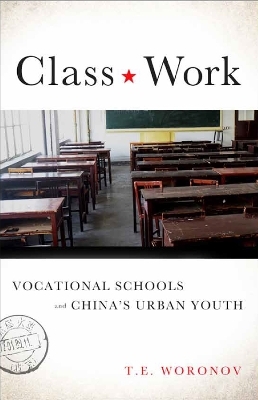
Class Work
Stanford University Press (Verlag)
978-0-8047-9541-8 (ISBN)
- Titel z.Zt. nicht lieferbar
- Versandkostenfrei innerhalb Deutschlands
- Auch auf Rechnung
- Verfügbarkeit in der Filiale vor Ort prüfen
- Artikel merken
Class Work explores the consequences for youth who have failed these exams, through an examination of two urban vocational schools in Nanjing, China. Through a close look at the students' backgrounds, experiences, the schools they attend, and their trajectories into the workforce, T.E. Woronov explores the value systems in contemporary China that stigmatize youth in urban vocational schools as "failures," and the political and economic structures that funnel them into working-class futures. She argues that these marginalized students and schools provide a privileged window into the ongoing, complex intersections between the socialist and capitalist modes of production in China today and the rapid transformation of China's cities into post-industrial, service-based economies. This book advances the notion that urban vocational schools are not merely "holding tanks" for academic failures; instead they are incipient sites for the formation of a new working class.
T.E. Woronov is Senior Lecturer of Anthropology at the University of Sydney.
Contents and Abstracts1Numeric Capital chapter abstractThis chapter presents an overview of the high-stakes exam system that places up to half of China's secondary school students in vocational education and seeks to understand the stigmatization of vocational students in urban China. Refuting the common "culturalist" perspective that naturalizes Chinese students' desires for ever-increasing educational credentials as a reflex of traditional Chinese culture, this chapter instead focuses on the contemporary ideology and policies of human capital accumulation. The chapter argues that the this ideology turns young people into a fetish, whereby their exam scores stand for social value, and replace the child and his/her labor with a number. This regime of value is called "numeric capital," a term designed to capture both the ideology of human capital accumulation that specifies a normative life course for young people of striving for measurable educational and material achievement, and the state-based structures that make this possible.
2Vocational Schools chapter abstractChapter 2 outlines the history of vocational education in China, highlighting its roots in Republican-era efforts to limit urban working classes' aspirations for social mobility. This chapter introduces the Bridge and Canal Schools, the book's ethnographic research sites, and discusses the implications of their different institutional settings. While one school was a contemporary version of a socialist-era "worker training school," whose graduates were assigned jobs through within the socialist labor allocation into the work unit (danwei) system, the other was based entirely on capitalist models of labor reproduction. These different structures demonstrate some of the ways the socialist and capitalist modes continue to co-exist and intersect in urban China.
3Vocational Students chapter abstractChapter 3 introduces the students at both schools, focusing on the social diversity represented in the vocational school classrooms as students from urban working class, rural, and second-generation migrant families come together to study. This chapter first challenges the common stereotypes of vocational secondary students, showing how their decisions to enter vocational studies mark them as moral and filial youth. Then seeking to understand the class formations taking place in and through vocational schools, the chapter argues that the HSEE, the testing regime that fails vocational students out of the academic stream, acts as a class sorting mechanism. The exam funnels working-class students, who cannot afford other options, into vocational schools, while graduates of these schools are locked out of future white-collar and middle-class jobs, thereby forming a new sector of the working class.
4Teachers, Teaching and Curriculum chapter abstractChapter 4 discusses teachers and teaching, arguing that teachers' contractual relationship with their employers (either permanent or temporary) influenced pedagogy in the schools. the kind of. Permanent teachers were hired through the socialist "iron rice bowl" system, managed through redistributive logic and moral suasion. The part-time teachers worked under a rational capitalist logics, and modeled flexible labor practices for their students. The chapter examines daily classroom practice, and shows that both schools "devocationalized" their technical curricula, by stripping their instruction of actual skills training. Extending the discussion about class sorting from Chapter 3, this chapter looks at classes in language standardization in the two schools to show how these young people were unprepared to enter working-class jobs in the new service economy.
5Creating Identities chapter abstractChapter 5 looks at how the students think about themselves, and the question of students' identity. Rather than assuming that the students all "had" an identity that needed to be "voiced," this chapter argues that the students' subjectivities had to be actively produced. The chapter explores the teachers' efforts to get the students to create narratives of themselves as desiring, choosing subjects, propelled into futures driven by ever more accumulation of material goods and numeric capital. The students, however, resisted these efforts, creating identities as moral, filial and cosmopolitan youth on different terms than those established by their teachers and dominant middle-class discourse. Chapter 5 explores the contradictory pressures on the vocational students to both express and restrain their self expression in key domains, and how these contradictions are linked to the students' class positions.
6Jobs, Internships, and the School-to-Work Transition chapter abstractChapter 6 follows vocational school graduates as they attended internships, training classes to prepare for job interviews, job fairs, and to their first jobs, to understand the school-to-work transition as they entered the service economy. This chapter explores several key issues that the students discovered in process of job hunting. First, in the absence of family connections, they had to negotiate how their vocational credential appealed to employers, and whether or not their education distinguished them from rural migrant laborers. Second, although the entry-level service sector provided seemingly endless opportunity for horizontal mobility, there was limited opportunity for social or horizontal mobility as they rapidly switched jobs.
7Precarious China chapter abstractChapter 7 meets some of the vocational school graduates several years later. This chapter summarizes their experiences as new members of the urban working class, and compares the vocational school graduates with some of their age-mates around the world. Arguing that they are forming a new Chinese "precariat," this chapter positions the students and their lives as young adults within a global framework of service workers in short-term, low-paid, tenuous, work. This chapter also explores the question of class consciousness, arguing that although several factors seem to constrain the emergence of working-class consciousness among this group of new service-sector workers, their history of passive resistance in school and their creative approaches to the challenges of adult life may open the possibility of new identities and new forms of collective consciousness in the future.
| Erscheint lt. Verlag | 25.11.2015 |
|---|---|
| Verlagsort | Palo Alto |
| Sprache | englisch |
| Maße | 152 x 229 mm |
| Gewicht | 431 g |
| Themenwelt | Sozialwissenschaften ► Ethnologie |
| Sozialwissenschaften ► Pädagogik ► Allgemeines / Lexika | |
| Sozialwissenschaften ► Pädagogik ► Berufspädagogik | |
| Sozialwissenschaften ► Soziologie | |
| ISBN-10 | 0-8047-9541-X / 080479541X |
| ISBN-13 | 978-0-8047-9541-8 / 9780804795418 |
| Zustand | Neuware |
| Haben Sie eine Frage zum Produkt? |
aus dem Bereich


